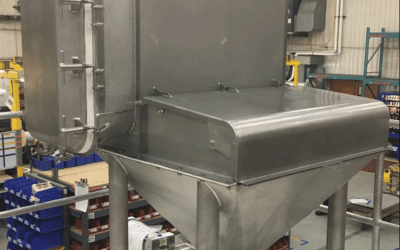Dust Collection System Design
ABM Equipment specializes in engineering and maintaining dust collection systems for various industries. As distributors for Schenck Process, we ensure the correct design and integration of systems. Contact us for assistance or use our guide for the selection and design process.
Uncontrolled dust from ingredients can not only affect the quality of the finished product but can also cause air quality, traction, and pest issues. Proper dust collection is critical for maintaining a clean and safe workspace, as well as complying with regulations.
Considerations
When designing a dust collection system for food-processing related industries, there are several factors to consider:
Regulations
First and foremost, the system must be designed to meet regulatory requirements set forth by the Occupational Safety and Health Administration (OSHA) and the Food and Drug Administration (FDA). These regulations specify the maximum allowable levels of dust in the air and outline the necessary steps to ensure worker safety, and each industry and municipality will have their own requirements. This can be due to a number of concerns such as absorption of hazardous materials through the lungs, particle load on the lungs of otherwise harmless materials, attraction of pests, and explosivity of materials (like flour) once the particle sizes get small enough. Though dust collection is often necessary, sometimes the letter of the law can be impractical and ill-serving to the intent. We can help you navigate these waters and identify creative workarounds when this is the case.
Particle Size
Another crucial factor to consider when designing a dust collection system for food-processing related industries is the type of material being processed. For example, if you are processing sugar or other fine powders, you will need a system with a high-efficiency filtration system to ensure that the dust particles are captured before they are released into the air. In contrast, if you are processing larger food items, such as fruits or vegetables, you may need a system with a more robust collection system that can handle larger particles.
Resource Proximity & Accessibility
Naturally it is essential to consider the layout of your facility when designing a dust collection system. You will need to take into account the location of your equipment, the flow of air in your workspace, and the proximity of workers to the dust collection system. This will help us determine the most effective placement of the collection points, ductwork, and other components of the system.
Material compatibility
It’s important to ensure that the materials used in your dust collection system are compatible with the materials being processed in your facility. For example, some types of ductwork may not be suitable for use with certain food products, as they may react with said product.
Noise levels
Dust collection systems can produce a significant amount of noise, which can be a concern in some environments. To minimize noise levels, you may need to consider adding noise-reducing features to your system, such as sound-dampening insulation or a muffler.
Maintenance
Regular maintenance is essential for ensuring that your dust collection system continues to function effectively and efficiently. This may include tasks such as replacing filters, cleaning ductwork, and inspecting the system for damage or wear.
Explosion Risk
There are several explosion-proof or dampening panel and configuration options for nearly every type of dust collection system. We will provide you with the options, information, and recommendations to help you make informed decisions.
Presence of Silo
If silos are part of your process, your system will need to be sized up to account for blow-back during filling.
Flexibility
Finally, it’s important to design your dust collection system with flexibility in mind. As your facility’s needs change over time, you may need to modify or expand your system to accommodate new equipment or processes. By designing a system that can easily be modified or expanded, you can save a lot of resources by not having to get a new dust collector.
Types of Dust Collection Systems
Baghouses
Baghouses, or bag filters, iare a type of dust collection system that uses filter bags to capture and remove dust and other particulate matter from industrial processes. These systems are commonly used in a wide range of industries, including...
Cartridge Dust Collectors
Cartridge dust collectors use pleated filters, like those in your car and home, to filter small particulates out of the air of manufacturing facilities. The filters can be round or rectangular, and made of natural or synthetic materials depending...
Cyclone Dust Collectors
Cyclone dust collectors use centrifugal force to separate dust particles from the air stream. They are designed for use in a wide range of industrial applications, including cement and minerals processing, power generation, and chemical...



